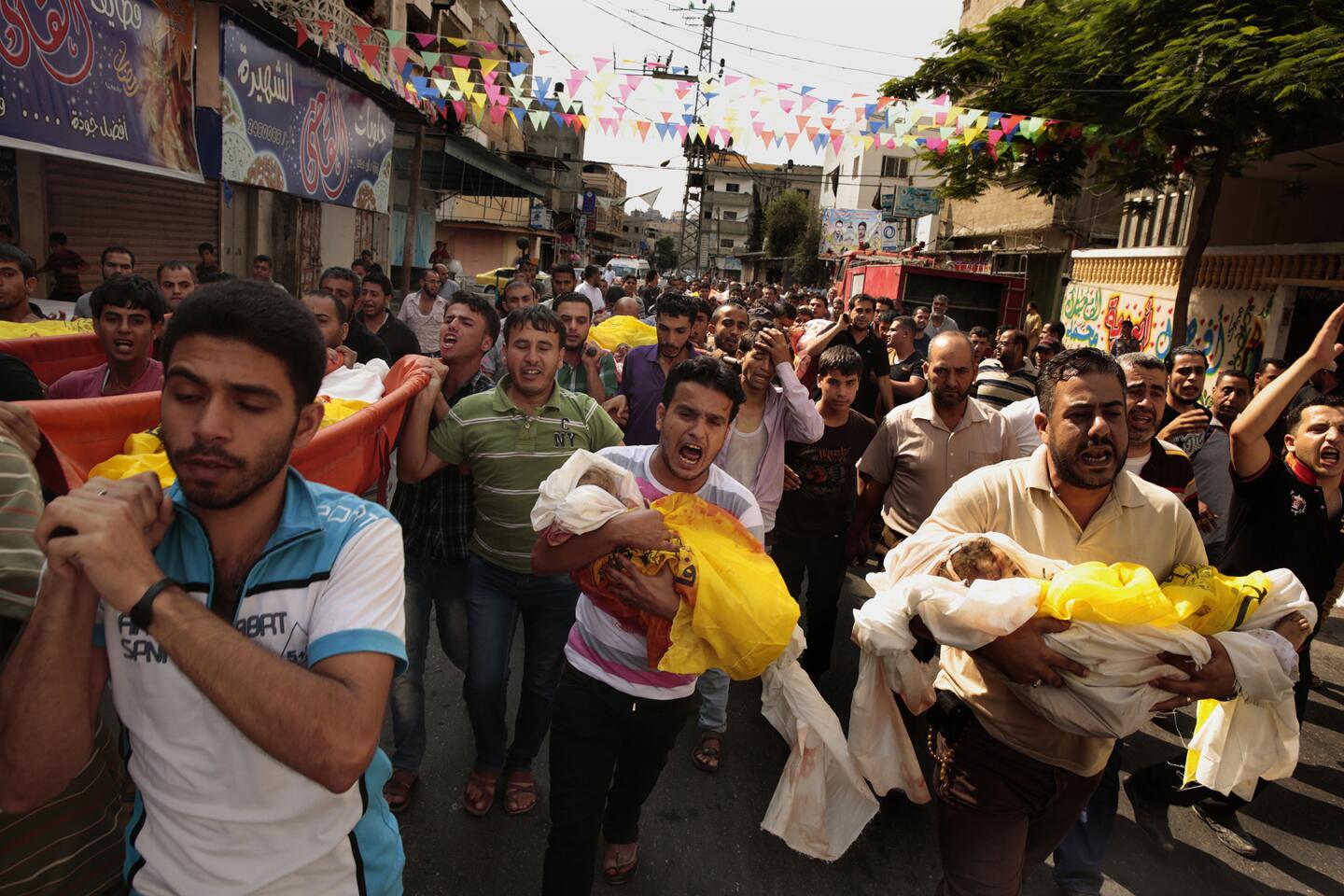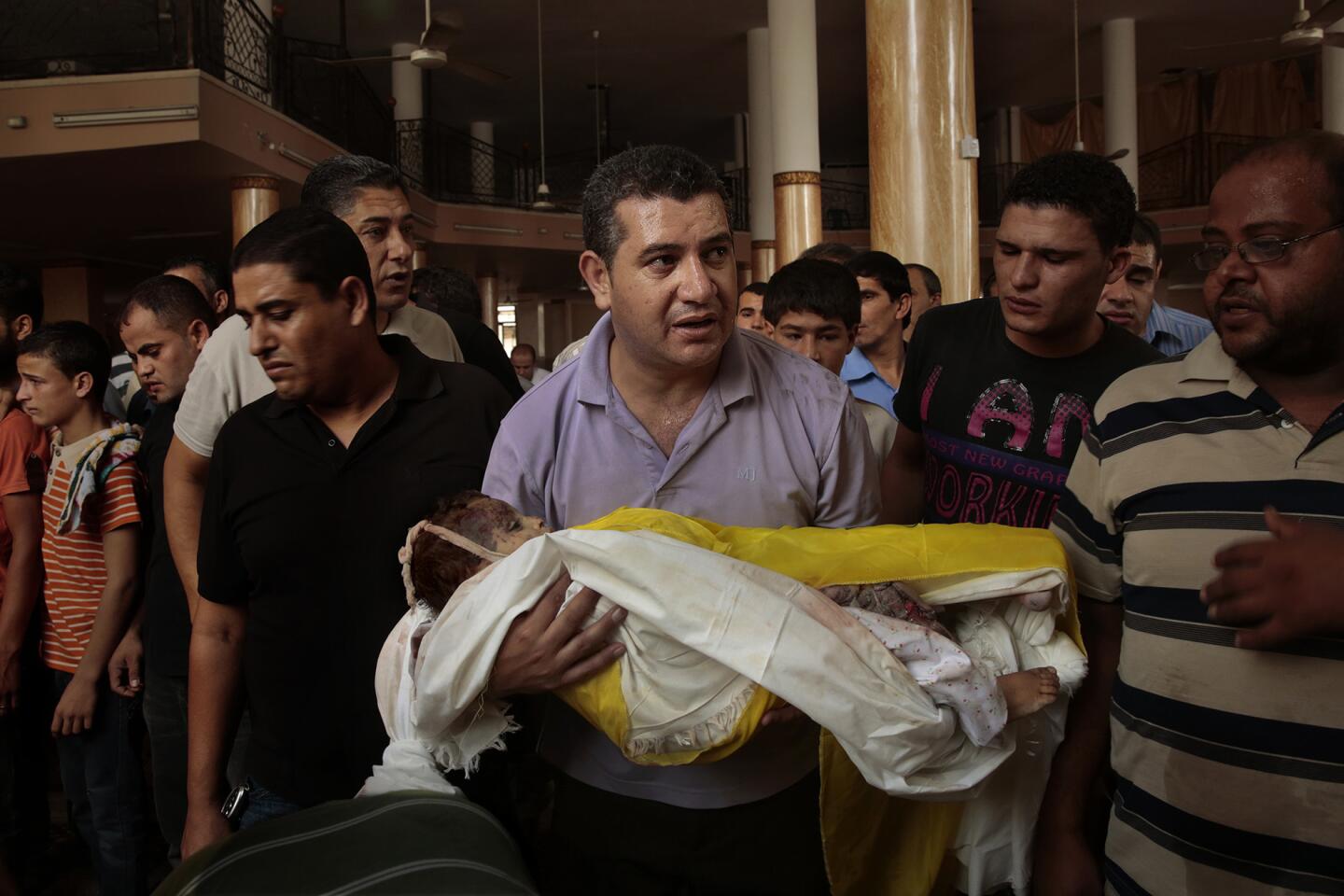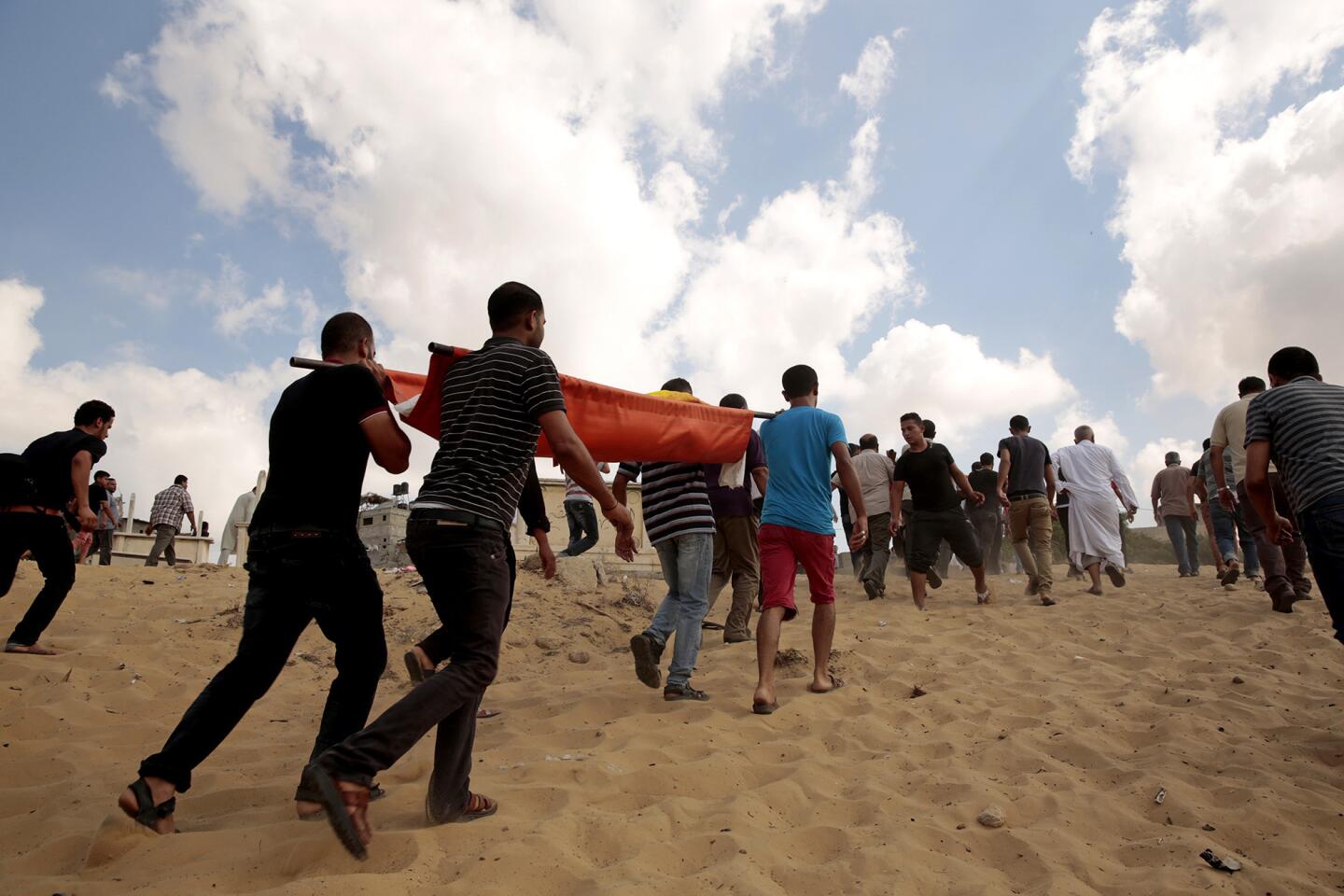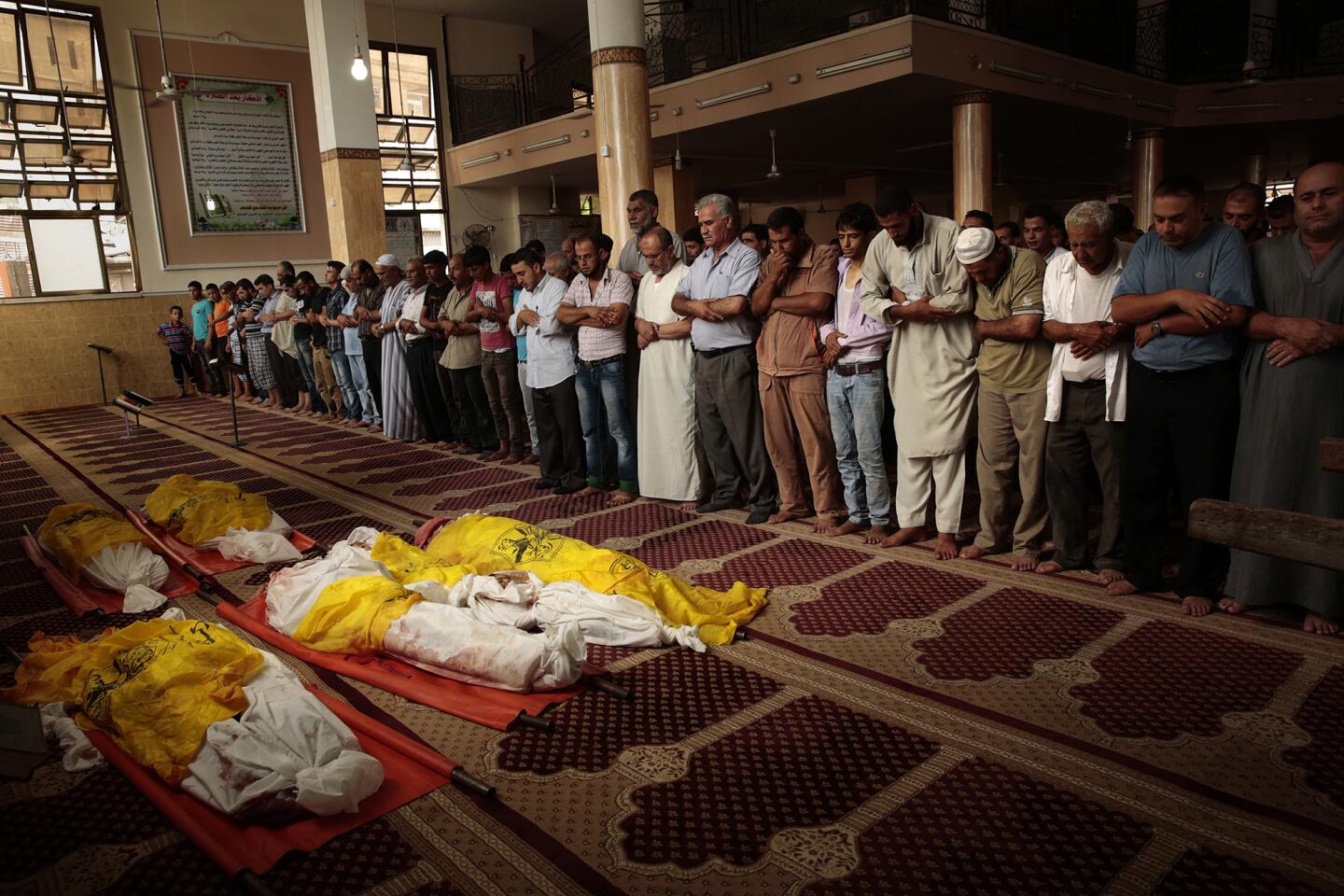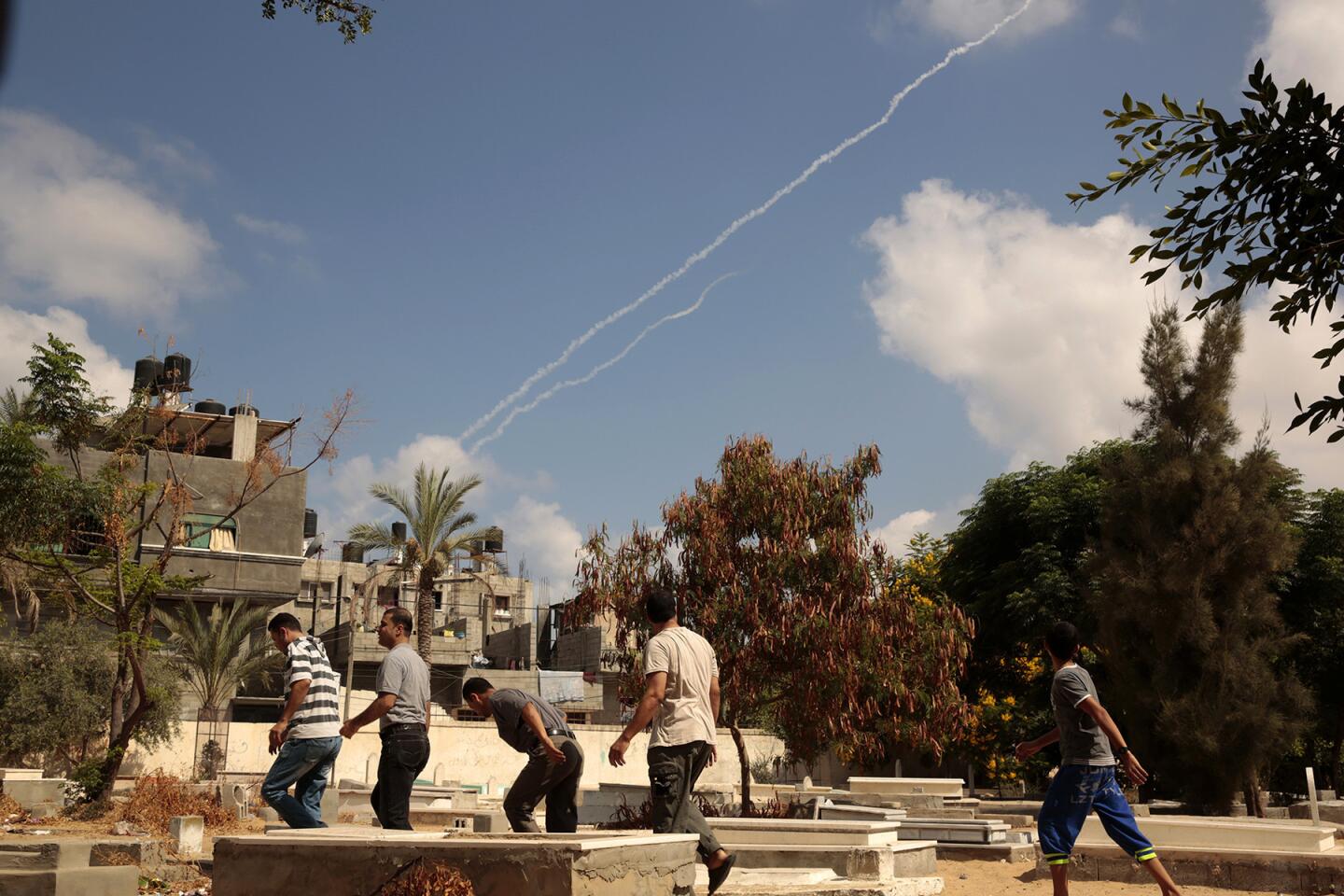As civilian toll mounts in Gaza, U.N. chief Ban heads to Mideast
- Share via
Reporting from Jabaliya, Gaza Strip — Before dawn Saturday, eight members of the Abu Jarad family were killed when their house was hit during an Israeli barrage on the town of Beit Hanoun in the northern Gaza Strip.
The bodies, including those of four small children wrapped in bloody white shrouds, were carried later from the Jabaliya hospital on orange stretchers, hoisted above the shoulders of a crowd of mourners shouting, “God is great.”
There would be no gathering at the family home before they were buried. There were no survivors to receive them, witnesses said.
There have been many such mass casualties in the 12 days since Israel began its latest offensive in the Gaza Strip, a densely populated coastal enclave run by the militant group Hamas. Ten other bodies were pulled out of a destroyed home in the southern Gaza town of Khan Yunis on Saturday morning, the Maan News Agency reported.
About 75% of the deaths in Gaza have been civilians, according to United Nations estimates.
As the death toll neared 340 on Saturday, U.N. Secretary-General Ban Ki-moon headed to the region to lend his support to international efforts to broker a cease-fire. Ban and other world leaders expressed alarm over the escalation in hostilities, including relentless rocket fire into Israel and the launch of an Israeli ground operation in Gaza.
“This escalation will inevitably increase the already appalling suffering of the affected civilian populations,” Ban’s spokesman said in a statement that appealed to both sides to do their utmost to ensure the protection of civilians.
Israeli leaders long have said they go to great lengths to limit civilian casualties.
When homes are targeted that Israel believes are being used by Hamas as command and control centers, the occupants usually receive a phone call telling them to leave, the Israeli military said. That may be followed by a warning thud from a projectile with no explosive warhead landing on the roof.
But as the bombardments have intensified, some families have complained that they received no specific warning of a pending attack, according to Palestinian reports.
Instead, the Israel Defense Forces have been sending out broader alarms, dropping leaflets and sending recorded messages to residents’ phones advising them to clear out when attacks are about to begin in their areas. Residents of Beit Hanoun received repeated warnings before Israel launched its ground operation last week.
Lt. Col. Peter Lerner, a military spokesman, said Israeli forces planned to distribute more leaflets Saturday advising residents of Khan Yunis and the nearby refugee camps of Maghazi and Bureij to move out.
The number of people sheltering at schools operated by the United Nations has swelled from fewer than 20,000 to more than 50,000 in the last week.
But many others have chosen to remain in their homes. They say there is no safe place to go in the less than 30-mile-long enclave while Israeli warplanes are in the air.
Israel blames Hamas for operating from residential areas, accusing the militia of using civilians as human shields.
“I don’t think the international community should create any kind of symmetry between a democracy legitimately acting in its own self-defense, trying to avoid civilian casualties, and a terrorist organization that deliberately targets millions of innocent civilians,” Prime Minister Benjamin Netanyahu said in a meeting Saturday with visiting French Foreign Minister Laurent Fabius.
Although Israel’s antimissile system has helped keep its casualties to a minimum, more than 1,700 rockets have been fired from Gaza since July 8, sending people racing for bomb shelters in cities as far away as Tel Aviv and Jerusalem, 40 miles away or more.
A 32-year-old man was killed and four people were wounded in a rocket strike Saturday outside the Israeli town of Dimona.
The rocket landed in a Bedouin village, where residents complain of little or no protection from the projectiles.
He was the second Israeli civilian killed during the conflict.
Two Israeli soldiers were killed and two were injured Saturday in a battle with a group of Palestinian militants who emerged from a tunnel close to the Ein Hashlosha kibbutz, near central Gaza, dressed in Israel Defense Forces uniforms. The fighters fired machine guns and an antitank missile at an Israeli patrol, which returned fire, killing one of them and driving the rest back into Gaza, the military said.
Later that evening, another fighter emerged from a hidden shaft and opened fire on Israeli troops, who returned fire and killed him, the military said.
Israel says its ground operation has uncovered 13 of these tunnels, with dozens of shafts running under homes and greenhouses.
“These tunnels aren’t for hiding. They are intended for large attacks in Israeli communities and army bases,” Israel’s chief military spokesman, Brig. Gen. Moti Almoz, told reporters.
Israelis are using robots to check the tunnels for booby-traps before blowing them up or destroying them with excavators and other heavy equipment. But they believe there are many more shafts concealed along the border between Israel and the Gaza Strip.
As members of the Abu Jarad family were lowered into their graves Saturday, heavy gunfire sounded nearby.
They were not the only ones being buried that day. A body arrived at the cemetery on a bed frame covered in a brown bedspread.
The skies above were a brilliant blue, making it easy to see the military fire streaking overhead in both directions. For several minutes, there was continuous gunfire.
The mourners did not flinch.
Times staff writer Zavis reported from Ashkelon, Israel, Times staff photographer Cole from Jabaliya and special correspondent Sobelman from Jerusalem.
More to Read
Sign up for Essential California
The most important California stories and recommendations in your inbox every morning.
You may occasionally receive promotional content from the Los Angeles Times.
